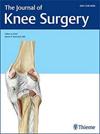Patellar Tendon Ruptures after Total Knee Arthroplasty.
IF 1.6
4区 医学
Q3 ORTHOPEDICS
引用次数: 0
Abstract
Patellar tendon rupture following total knee arthroplasty (TKA) is a rare, but devastating complication. These injuries occur most frequently in the acute period following TKA due to trauma to the knee. Patellar tendon ruptures that disrupt the extensor mechanism create a marked functional deficit, impacting every facet of daily life. In complete ruptures of the patellar tendon, repair or reconstruction is typically indicated; however, complication rates following intervention remain high, between 25 to 63%. Operative intervention remains the mainstay of treatment, with only certain specific situations where nonoperative intervention is appropriate. Operative treatments include repair with or without augmentation or reconstruction. Augmentation does reduce the high risk of complications, bringing rates down from 63 to 25%. Augmentation options include autografts, allografts, synthetic grafts, or synthetic meshes. Despite advancements, outcomes are unpredictable, and complications are common, highlighting the need for further research to improve treatment protocols. Operative techniques are chosen based on the acuity, location of disruption, and status of the residual soft tissues. This article provides an overview of patellar tendon ruptures following TKA, the various treatment options, and the recommendations of the senior authors for each common type of patellar tendon injury encountered.全膝关节置换术后髌骨肌腱断裂。
全膝关节置换术(TKA)后髌骨肌腱断裂是一种罕见但却具有破坏性的并发症。这种损伤最常发生在全膝关节置换术后的急性期,原因是膝关节受到创伤。髌腱断裂会破坏伸肌机制,造成明显的功能障碍,影响日常生活的方方面面。在髌腱完全断裂的情况下,通常需要进行修复或重建;然而,干预后的并发症发生率仍然很高,在 25% 到 63% 之间。手术干预仍是治疗的主流,只有在某些特殊情况下才适合采用非手术干预。手术治疗包括带或不带增强或重建的修复术。增强手术确实能降低并发症的高风险,使并发症发生率从 63% 降至 25%。植入物包括自体移植物、异体移植物、合成移植物或合成网。尽管技术不断进步,但结果仍难以预测,并发症也很常见,因此需要进一步研究以改进治疗方案。手术技术的选择基于损伤的敏锐度、破坏的位置和残余软组织的状态。本文概述了 TKA 术后髌腱断裂的情况、各种治疗方案以及资深作者对每种常见髌腱损伤类型的建议。
本文章由计算机程序翻译,如有差异,请以英文原文为准。
求助全文
约1分钟内获得全文
求助全文
来源期刊

Journal of Knee Surgery
ORTHOPEDICS-
CiteScore
4.50
自引率
5.90%
发文量
139
期刊介绍:
The Journal of Knee Surgery covers a range of issues relating to the orthopaedic techniques of arthroscopy, arthroplasty, and reconstructive surgery of the knee joint. In addition to original peer-review articles, this periodical provides details on emerging surgical techniques, as well as reviews and special focus sections. Topics of interest include cruciate ligament repair and reconstruction, bone grafting, cartilage regeneration, and magnetic resonance imaging.
 求助内容:
求助内容: 应助结果提醒方式:
应助结果提醒方式:


